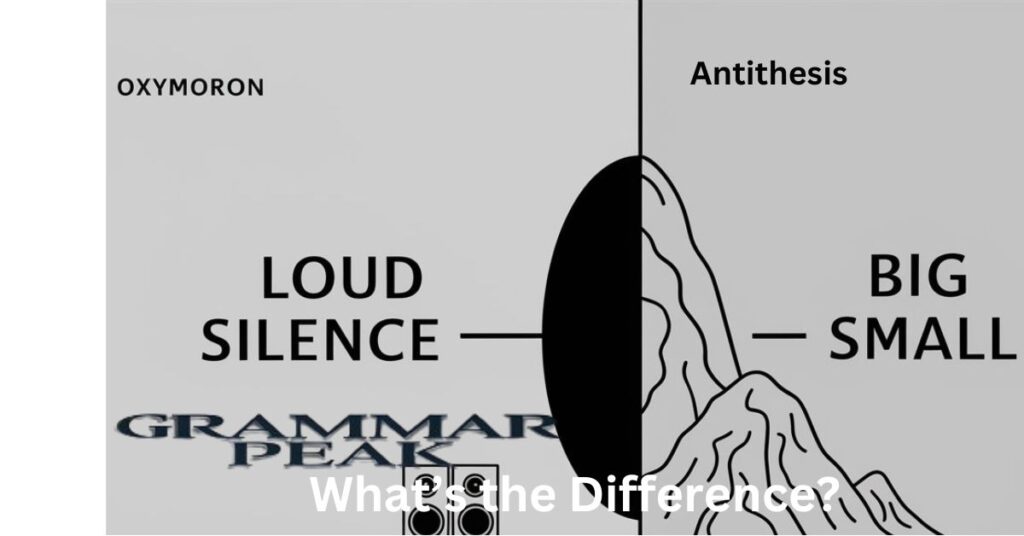Understanding the difference between Oxymoron vs Antithesis can enhance your writing skills. Both are rhetorical devices that play with language in unique ways. An oxymoron combines contradictory terms, while an antithesis juxtaposes contrasting ideas.
This blog post will explore these two literary devices in-depth, providing examples and tips for effective use. By the end, you’ll see how these tools can add richness to your creative writing and improve your communication skills.
What is Oxymoron?
An oxymoron is a figure of speech that combines two opposing or contradictory terms. This pairing creates a unique phrase that often conveys a deeper meaning.
Examples of Oxymoron
- Bittersweet
- Deafening silence
- Jumbo shrimp
- Clearly confused
- Awfully good
- Alone together
- Exact estimate
- Cruel kindness
- Passive aggression
- Definite maybe
Origins of Oxymoron
The word “oxymoron” has Greek origins, derived from “oxus” meaning sharp and “moros” meaning dull. This juxtaposition reflects the very essence of what an oxymoron represents. Historically, it has been used in literature to create tension and depth. Many classic literary works feature oxymorons as a way to enhance meaning and provoke thought.
In ancient Greek theater, playwrights used this device to express complex themes. It helped convey the struggles between opposing forces. This technique has persisted through the ages, making it a powerful tool in modern writing. Understanding its origins can help writers appreciate its impact on language.
You will like Oxymoron vs Antithesis: What’s the Difference?
What is Antithesis?
Antithesis is another powerful rhetorical device that involves contrasting ideas placed in parallel structures. It aims to highlight the differences between two opposing concepts. For example, “It was the best of times, it was the worst of times” effectively contrasts two extremes. This technique not only clarifies the message but also adds a layer of complexity to writing.
Antithesis enhances sentence clarity by presenting conflicting ideas in a balanced manner. It encourages readers to think critically about the relationships between these ideas. Writers often use this device in persuasive writing to emphasize a point or argument.
Examples of Antithesis
- It was the best of times; it was the worst of times.
- To err is human; to forgive, is divine.
- You can take the girl out of the country, but you can’t take the country out of the girl.
- We must learn to live together as brothers or perish together as fools.
- That’s one small step for man, one giant leap for humanity.
- Love is an ideal thing; marriage is a real thing.
- The strong man will retain his strength, while the weak will lose their power.
- In the end, we will remember not the words of our enemies, but the silence of our friends.
- It’s not the years in your life that count; it’s the life in your years.
- The light shines brightest in the darkest of times.
Origins of Antithesis
The term “antithesis” comes from the Greek word meaning “opposition” or “contrast.” This literary device has roots in classical rhetoric, where it was employed to enhance arguments and convey complex ideas. Historically, antithesis has been a staple in oratory and persuasive speeches.
It helps speakers emphasize their points by contrasting them with opposing ideas. Throughout history, many famous speakers have used antithesis to captivate their audiences. This technique allows for a more dynamic presentation of ideas, making the message more impactful.
Oxymoron vs Antithesis: The Differences
While both oxymoron and antithesis involve the juxtaposition of opposing concepts, they serve different purposes in writing. An oxymoron combines contradictory terms within a single phrase, creating a unique and often humorous effect.
In contrast, antithesis presents contrasting ideas in parallel structures, highlighting their differences.
To clarify these differences, let’s consider a comparison table:
| Aspect | Oxymoron | Antithesis |
| Definition | Pairs contradictory adjectives or nouns to create a unique expression. | Opposes two contrasting ideas to illustrate a point. |
| Example | “Deafening silence,” “Act naturally,” “Original copy.” | “To err is human; to forgive, divine,” “It was the best of times, it was the worst of times.” |
| Purpose | Conveys paradox and complexity in a single phrase. | Emphasizes contrasts to clarify opposing viewpoints. |
| Mechanism | Combines contradictory concepts in a brief phrase. | Places opposing ideas in direct comparison for impact. |
| Effect | Provokes thought and reflection through contradiction. | Enhances clarity and persuasion by highlighting differences. |
| Usage | Often found in creative writing, song lyrics, and humor. | Common in persuasive essays, speeches, and literary works. |
Read more About Oxymoron vs Antithesis: What’s the Difference?
How To Use Oxymoron and Antithesis In Sentences
Using oxymoron and antithesis effectively requires an understanding of their unique properties. When crafting oxymorons, consider the emotions or ideas you want to convey. Think about how opposing terms can create a striking effect.
Using Oxymoron
- The comedian delivered a deafening silence after his punchline fell flat.
- She felt a bittersweet sense of nostalgia as she packed up her childhood home.
- The jumbo shrimp on the menu caught everyone’s attention at the seafood restaurant.
- His confused expression made it obvious he didn’t understand the instructions.
- The movie was an awfully good thriller that kept everyone on the edge of their seats.
- They enjoyed a living dead experience at the haunted house attraction.
- The open secret about the surprise party was known by everyone except the guest of honor.
- The virtual reality game provided an immersive experience that felt incredibly real.
- She wore a pretty ugly sweater to the holiday party, and it became the center of attention.
- The original copy of the manuscript was lost, leaving only the printed versions behind.
Using Antithesis
- Embrace your fears, but don’t let them control your life.
- Success is not the key to happiness; happiness is the key to success.
- Amid the chaos, there is also opportunity.
- You can choose to be a victim, or you can choose to be a survivor.
- The more I learn, the more I realize how much I don’t know.
- He is not only a great leader, but also a compassionate friend.
- We must face the challenges ahead, yet we should celebrate our achievements thus far.
- To love and be loved is a profound experience, yet it can also bring great pain.
- To gain freedom, one must sometimes endure restrictions.
- Life can be both beautiful and tragic, often at the same time.
Combining Oxymoron and Antithesis
Combining oxymoron and antithesis can create a rich tapestry of meaning in your writing.
- Identify the Contrast: Begin by recognizing the conflicting ideas or themes you wish to highlight in your work. Reflect on how these contrasts contribute to the larger narrative or argument.
- Craft an Oxymoron: Create a phrase that juxtaposes two contradictory terms, enhancing the complexity of the ideas you’re exploring. This should encapsulate the essence of the tension between the contrasting elements.
- Integrate Antithesis: Formulate a sentence that presents both ideas in a balanced manner, using parallel structure. This will allow the oxymoron to coexist with the contrasting concepts effectively.
- Consider Context: Think about the setting and purpose of your writing. Ensure that the combination of oxymoron and antithesis aligns with the tone and message you aim to convey to your audience.
- Refine and Revise: Review your sentence for clarity and impact. Make adjustments to improve flow and ensure that both the oxymoron and antithesis enhance the overall expression of your ideas.
- Test for Effectiveness: Read the combined statement aloud or share it with others to gauge its effectiveness. Consider whether the juxtaposition creates the intended emotional or intellectual response.
- Use in Various Contexts: Experiment with applying this technique in different types of writing, such as poetry, essays, or speeches, to see how the combination of oxymoron and antithesis enriches your expression and engages your audience.
Examples Of Oxymoron and Antithesis Used In Sentences
Oxymoron
- The bittersweet victory left the team both proud and saddened.
- In the middle of the jumbo shrimp buffet, they found their favorite dish.
- His deafening silence during the meeting spoke louder than words.
- The original copy of the painting was admired for its authenticity.
- She felt a genuine imitation of the artwork was just as valuable.
- Their open secret was known by everyone in the neighborhood.
- The act naturally remark confused the audience during the performance.
- The living dead roamed the streets in the eerie movie scene.
- He made an awfully good impression at his job interview.
- The fashion show featured a pretty ugly collection that grabbed attention.
Oxymoron
- The silence roared in the crowded room.
- I love the chaos of a well-organized plan.
- She had a cold fire in her eyes, igniting my passion.
- It’s a bittersweet symphony of joy and sorrow.
- Their relationship was a living ghost, haunting yet vibrant.
- He spoke in a loud whisper, capturing everyone’s attention.
- The darkness illuminated the path I needed to take.
- Her smile was a painful comfort in a world of uncertainty.
- He was a wise fool, always learning from his mistakes.
- In a crowded solitude, she felt utterly alone.
Combined Use of Oxymoron and Antithesis
- I’m a painfully happy person, always smiling through the tears.
- The deafening silence of his absence made her presence felt even more.
- In a world filled with random order, chaos finds its meaning.
- Her cold warmth was a paradox that drew everyone closer.
- The bittersweet victory left a sour taste amidst the sweet celebration.
- His honest lies created a web of trust and betrayal.
- In the beauty of the ugly truth, we often find our strength.
- The dark light of truth shone brightly in the shadows of deception.
- She wore a cheerful frown, masking the joy beneath her sadness.
- Their empty fullness spoke volumes about their hidden desires.
Common Mistakes to Avoid when Using Oxymoron and Antithesis
While oxymorons and antithesis can be powerful rhetorical devices, it’s important to use them judiciously and avoid common pitfalls.
- Overuse: Employing oxymorons and antithesis too frequently can lead to a dilution of their effectiveness, making the writing feel forced or cliché. It’s important to apply these devices judiciously to maintain their strength and impact.
- Lack of Context: Introducing oxymorons and antithesis without proper context can confuse readers. Ensure that these elements are relevant to the overall theme and narrative, enhancing rather than detracting from the message.
- Mismatched Contrasts: Using contrasting ideas that do not align well or make sense together can weaken the intended effect. Carefully select pairs that genuinely highlight the tension or relationship you want to convey.
- Poor Placement: Positioning oxymorons and antithesis awkwardly within a sentence can disrupt the flow and clarity of your writing. Aim for strategic placement to enhance readability and ensure the devices are easily understood.
- Lack of Clarity: If the meaning behind the oxymoron or antithesis is unclear, it may confuse the reader instead of illuminating your point. Strive for clarity in your expressions to ensure the contrast resonates effectively.
- Ignoring Tone: Failing to consider the tone of your writing can lead to inconsistencies when using oxymorons and antithesis. These devices should complement the overall mood, whether it’s serious, humorous, or reflective.
- Forced Creativity: Trying too hard to be clever with oxymorons and antithesis can result in unnatural phrasing. Let your ideas flow naturally, ensuring that the expressions feel authentic and not contrived.
- Misinterpretation: Readers may misinterpret the intended meaning of your oxymorons and antithesis if they are overly complex or obscure. Aim for expressions that are accessible and resonate with your audience’s understanding.
- Neglecting Audience: Failing to consider your audience’s familiarity with oxymorons and antithesis can lead to disengagement. Tailor your use of these devices to suit the knowledge and expectations of your readers.
- Inconsistent Style: Mixing different styles or tones when using oxymorons and antithesis can create a jarring reading experience. Maintain a consistent voice throughout your writing to ensure coherence and fluency.
.
Tips for Avoiding These Mistakes
To ensure your use of oxymorons and antithesis is impactful and meaningful, consider the following tips:
- Understand Their Purpose: Before using oxymorons and antithesis, clarify their role in your writing. They should enhance the narrative, highlight contrasts, or provoke thought, rather than being used as mere embellishments.
- Practice Moderation: Use oxymorons and antithesis sparingly to preserve their impact. A well-placed expression can be powerful, while excessive use can lead to confusion or fatigue for the reader.
- Provide Context: Ensure that your oxymorons and antithesis are framed within a clear context. This allows readers to grasp their significance and understand the nuances of your message.
- Choose Appropriate Contrasts: Select contrasts that genuinely complement each other and enhance the meaning you wish to convey. Thoughtful pairings will resonate more effectively with your audience.
- Consider Placement: Pay attention to where you position oxymorons and antithesis in your sentences. Strategic placement can improve flow and highlight the intended contrasts more clearly.
- Prioritize Clarity: Aim for clarity in your expressions. If an oxymoron or antithesis feels convoluted, consider simplifying it to ensure readers can easily grasp the intended meaning.
- Align with Tone: Be mindful of the overall tone of your writing when using these devices. Ensure that your choices reflect the mood and style you wish to convey, fostering cohesion throughout the piece.
- Seek Feedback: Share your writing with others to gain insights on how your oxymorons and antithesis are received. Feedback can help identify any confusions or areas for improvement.
- Revise Thoughtfully: During the editing process, revisit your use of oxymorons and antithesis. Look for opportunities to refine or enhance these expressions for greater impact.
- Read Widely: Expose yourself to well-crafted examples of oxymorons and antithesis in literature and other writings. Analyzing how skilled authors employ these devices can inspire and inform your own writing style.
Where to Use Oxymoron and Antithesis
Oxymorons and antithesis can be particularly effective in creative writing, poetry, speeches, and other forms of persuasive communication.
- Literary Writing: In literary works, oxymorons and antithesis can enhance character development and thematic exploration. They allow authors to convey complex emotions and contradictions, enriching the reader’s experience and understanding.
- Rhetorical Speeches: Speakers often use oxymorons and antithesis to emphasize key points and engage the audience. These devices can create memorable phrases that highlight contrasts, making arguments more persuasive and impactful.
- Advertising and Marketing: Brands frequently employ oxymorons and antithesis to create catchy slogans and memorable taglines. These devices can draw attention and provoke curiosity, making products or services stand out in a crowded market.
- Creative Writing: In creative writing, including short stories and essays, oxymorons and antithesis can add layers of meaning and intrigue. Writers can play with contradictions to challenge readers’ perceptions and provoke deeper thought.
- Speechwriting: Effective speechwriters utilize oxymorons and antithesis to craft compelling narratives. By juxtaposing opposing ideas, they can highlight important themes and resonate with audiences on an emotional level.
- Poetry: Poetry often relies on oxymorons and antithesis to evoke strong imagery and emotion. These devices can create tension and beauty, allowing poets to express complex feelings and ideas in a condensed form.
- Creative Branding: In branding, oxymorons and antithesis can be used to create a unique identity for a company or product. By presenting a distinctive contrast, brands can capture the essence of their offerings and appeal to consumers’ emotions.
- Dialogues in Scripts: In film and theater, characters can use oxymorons and antithesis in dialogue to reveal inner conflicts or complexities. This can add depth to character interactions and enhance the overall narrative.
- Social Media Content: Marketers and content creators can incorporate oxymorons and antithesis in social media posts to engage audiences. Clever contrasts can inspire shares and comments, boosting visibility and interaction.
- Editorial Writing: Editorials and opinion pieces can benefit from the use of oxymorons and antithesis to challenge prevailing views and provoke critical thinking. These devices can make arguments more compelling and stimulate discussion among readers.
Where Not to Use Oxymoron and Antithesis
While oxymorons and antithesis can be powerful tools, it’s important to use them judiciously.
- Formal or Technical Writing: In formal or technical documents, clarity and precision are paramount. The use of oxymorons and antithesis can introduce ambiguity and distract from the clear communication of facts and data.
- Casual Conversations: In everyday conversations, particularly when clarity is important, using oxymorons or antithesis may confuse the listener. Straightforward language is often more effective for casual discussions.
- Sensitive Topics: When discussing sensitive or controversial issues, using oxymorons and antithesis can trivialize the subject matter. It’s crucial to approach such topics with respect and seriousness to avoid offending others.
- Cultural or Social Sensitivities: In contexts where cultural or social sensitivities are at play, oxymorons, and antithesis can be misinterpreted or deemed inappropriate. Avoiding these devices helps ensure that communication is respectful and culturally aware.
- Overly Emotional Writing: In writing that aims to convey strong emotions, the introduction of oxymorons and antithesis can dilute the emotional impact. Direct and heartfelt expressions are often more powerful in these cases.
- Explanatory Writing: When the goal is to explain concepts or processes clearly, using oxymorons and antithesis can complicate understanding. It’s best to stick to straightforward language to ensure that readers grasp the information effectively.
- Complex Topics: For inherently complex subjects, introducing oxymorons and antithesis can add unnecessary confusion. Simplifying language and avoiding literary devices help clarify complex ideas for the audience.
- Legal Documents: In legal writing, precision is critical. The use of oxymorons and antithesis can lead to misinterpretation of terms and clauses. Clarity and unambiguity should always be prioritized in legal contexts.
- Instructional Material: When creating instructional content, clarity and directness are essential. Using oxymorons and antithesis can distract from the instructions, making it harder for readers to follow the guidance provided.
- Scientific Writing: In scientific literature, the focus is on accuracy and clarity. The use of oxymorons and antithesis can obscure findings and conclusions, complicating the communication of important research results.
FAQ” S
What is an oxymoron?
An oxymoron is a figure of speech that combines contradictory terms.
What is antithesis?
Antithesis is a rhetorical device that juxtaposes contrasting ideas in a balanced way.
How are oxymorons used in literature?
They enhance meaning and evoke strong imagery by highlighting contradictions.
Can oxymorons and antithesis be used in speeches?
Yes, they can add emphasis and engage the audience effectively.
Are oxymorons and antithesis the same?
No, while both involve contrasts, oxymorons combine contradictory terms, whereas antithesis contrasts whole ideas.
Conclusion
Mastering the art of oxymorons and antithesis can elevate your written and spoken communication, adding depth, nuance, and emotional resonance to your message. By understanding the unique characteristics and origins of these rhetorical devices, you can learn to wield them effectively, captivating your audience and leaving a lasting impression. As you continue to explore the world of oxymorons, antithesis, and their combined use

Mason Blake is an experienced blogger with a passion for language and communication. With years of expertise in crafting informative and engaging content, Mason shares valuable insights on grammar and writing. His clear, concise, and reader-friendly approach has earned him a loyal following, helping readers sharpen their language skills and master the art of effective communication.







